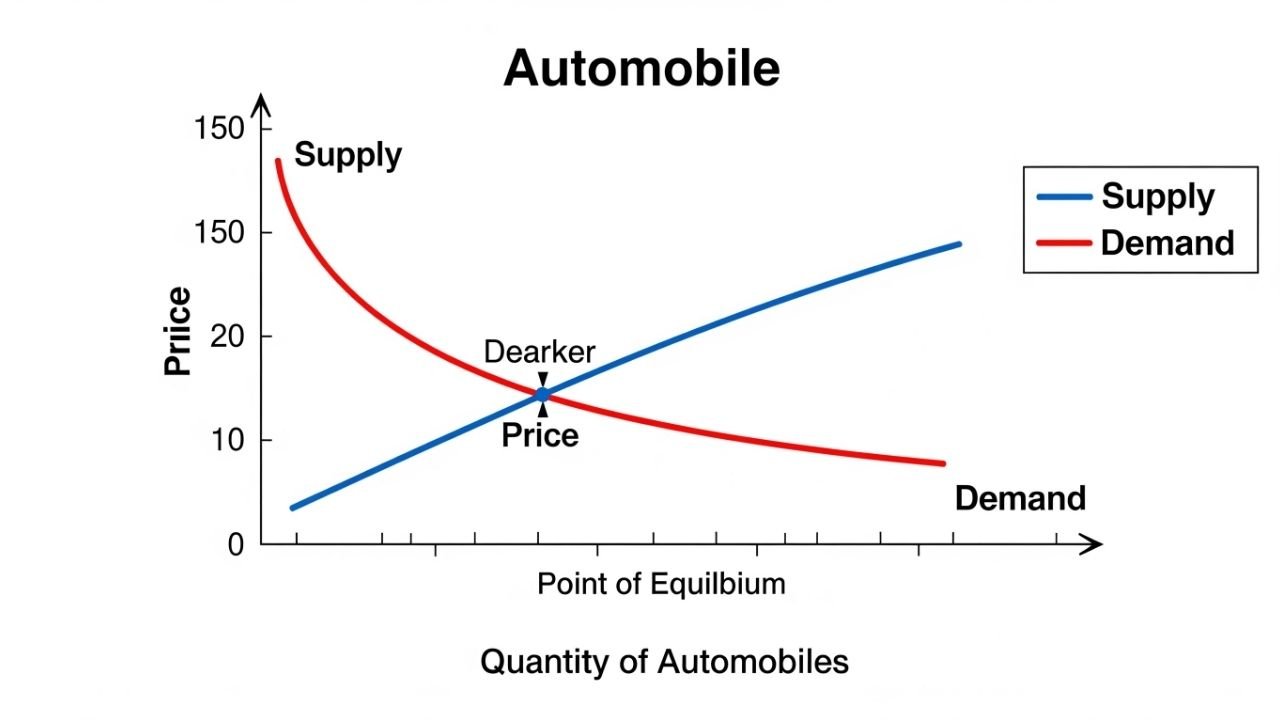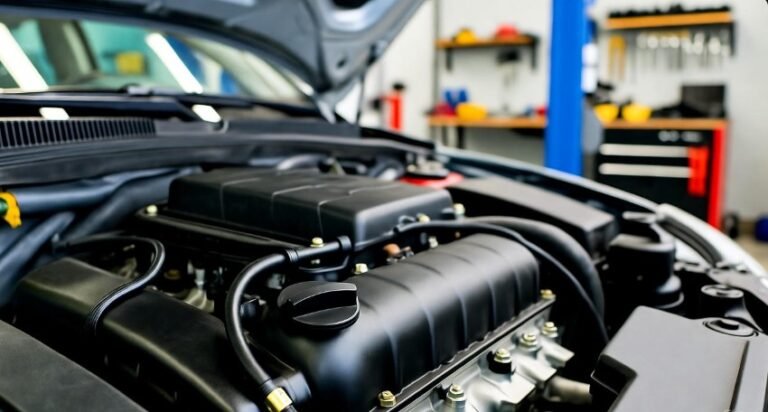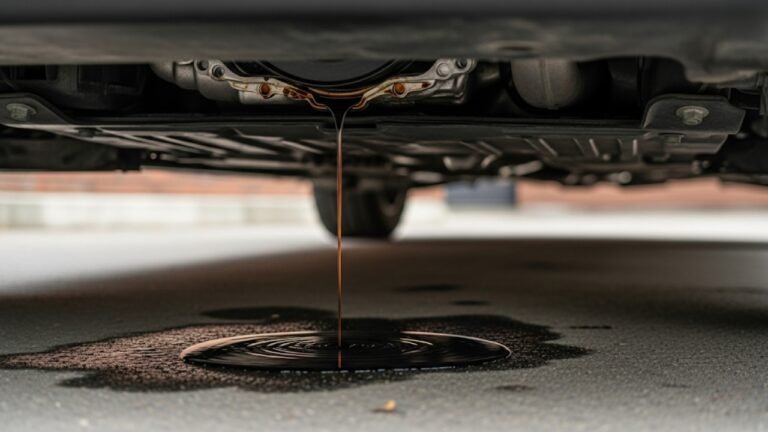Analyzing the Graph of Supply and Demand in the Automobile Industry

Have you ever wondered why car prices suddenly spike or why you can’t find a specific model even when you’re ready to pay? That’s because of how supply and demand dance together in the market. Picture this: a graph showing supply and demand in the market for automobiles, with a crisscross intersection that marks where both forces agree. In that diagram, P1 and Q1 represent the current equilibrium price and quantity. But what happens when the world throws a curveball—like a rise in gas prices, a new tax, or a factory shutdown?
This article breaks down these shifts in the car market using a clear and friendly approach. We’ll walk through how different events push or pull on the market, leading to a new market outcome and a fresh intersection point.
So grab a seat, and let’s explore how “the graph below shows supply and demand in the market for automobiles. In the diagram below, P1 and Q1 represent the current equilibrium price and quantity. For each of the following events, determine the new market outcome and indicate where the new equilibrium intersection point will be. Event new equilibrium point” actually works in real life.
Supply and Demand: The Heartbeat of the Automobile Market

When nothing changes, we stick to that point. But when events shake the market, that intersection moves. Think of it like shifting sands. The entire landscape changes.
Here’s a simple breakdown of what causes those shifts:
-
Demand shifts right: More people want cars → higher prices and quantity.
-
Demand shifts left: Fewer people want cars → lower prices and quantity.
-
Supply shifts right: More cars available → lower prices, more quantity.
-
Supply shifts left: Fewer cars available → higher prices, less quantity.
Now let’s go event by event and see how these changes look on the automobile supply and demand graph.
Event 1: Rising Gasoline Prices
If gas prices go up sharply, what do you think happens? Most buyers will lean toward fuel-efficient cars or avoid buying altogether. That means the overall demand for cars falls, especially big ones like SUVs and trucks.
New Market Outcome:
-
Demand curve shifts left.
-
New equilibrium point lies lower than P1 and Q1—prices drop, and fewer cars are sold.
Let’s look at this in a quick table:
| Factor Affected | Type of Shift | New Price | New Quantity |
|---|---|---|---|
| Demand | Decrease (Left) | Lower | Lower |
This drop might sound bad, but it’s also a chance for companies to innovate—like pushing electric cars or hybrids. I remember when my cousin skipped a car upgrade because gas was too expensive—he waited until hybrid prices dropped. That’s supply and demand in real time!
Event 2: Technological Advancements in Car Manufacturing
Now imagine a big breakthrough in car manufacturing. Say a new robot helps build cars twice as fast. Boom! That’s a rightward shift in supply.
New Market Outcome:
-
Supply curve shifts right.
-
New equilibrium point lies below P1 in price but above Q1 in quantity—cars are cheaper, and more are sold.
| Factor Affected | Type of Shift | New Price | New Quantity |
|---|---|---|---|
| Supply | Increase (Right) | Lower | Higher |
This is one of those feel-good moments where everyone wins. More cars, better prices, and more options on the lot. A friend once told me how he bought his dream sedan at a surprising discount during such a tech boom. He had been waiting for months, and it finally happened.
Event 3: Introduction of a Car Tax
Nobody likes extra taxes. If the government adds a new tax on car purchases, the cost goes up for consumers, reducing the demand. But also, manufacturers may scale back if their profits drop.
Depending on how it plays out, both supply and demand could shift left.
New Market Outcome:
-
Demand falls.
-
Possibly, supply falls too.
-
New equilibrium moves up in price (due to reduced supply) but way down in quantity.
| Factor Affected | Type of Shift | New Price | New Quantity |
|---|---|---|---|
| Demand & Supply | Decrease (Left) | Higher | Much Lower |
I once saw this happen when a luxury car tax came into effect in my city. Dealerships suddenly had too much stock, and people stopped buying until promotions kicked in. The graph’s new intersection point practically slid diagonally downward.
Event 4: Surge in Consumer Income
When people have more money, they often spend more. A rise in income makes consumers confident to buy new vehicles. That means an increase in demand.
New Market Outcome:
-
Demand curve shifts right.
-
New equilibrium will show a higher price and more quantity sold.
| Factor Affected | Type of Shift | New Price | New Quantity |
|---|---|---|---|
| Demand | Increase (Right) | Higher | Higher |
I remember during festival bonuses one year, car showrooms were flooded. People were buying even second or third cars for their families. That graph would’ve lit up with a strong demand curve shift to the right.
Event 5: A Factory Closure Due to Natural Disaster
Disasters are sad. Let’s say a major car production plant shuts down due to an earthquake. That’s a clear supply-side shock.
New Market Outcome:
-
Supply curve shifts left.
-
New equilibrium will mean higher prices and fewer cars available.
| Factor Affected | Type of Shift | New Price | New Quantity |
|---|---|---|---|
| Supply | Decrease (Left) | Higher | Lower |
This happened during a cyclone near a port city once. Imports were delayed, and dealers started charging premium prices for popular models. I saw a car that was ₹3 lakhs more expensive just due to shortage.
Quick Summary of Events and Graph Outcomes
| Event | Curve Shift | Price Change | Quantity Change | New Intersection Point |
|---|---|---|---|---|
| Gas Prices Increase | Demand ↓ | Lower | Lower | Left & Down |
| Tech Advances in Manufacturing | Supply ↑ | Lower | Higher | Right & Down |
| New Car Purchase Tax | Demand ↓ + Supply ↓ | Higher | Lower | Up & Left |
| Increase in Consumer Income | Demand ↑ | Higher | Higher | Right & Up |
| Factory Shutdown Due to Disaster | Supply ↓ | Higher | Lower | Left & Up |
Event 6: Price of Substitute Goods Drops
Now, let’s say the price of motorcycles or public transport drops significantly. What happens to the car market? These are substitute goods, and when their prices fall, more people will consider them instead of buying a car.
New Market Outcome:
-
The demand for cars will decrease.
-
The demand curve shifts left.
-
As a result, the equilibrium price and quantity both fall.
| Factor Affected | Type of Shift | New Price | New Quantity |
|---|---|---|---|
| Demand | Decrease (Left) | Lower | Lower |
A buddy of mine sold his old car and chose a scooter when fuel prices spiked. The cost of buying and maintaining the scooter was way less, and the decision made sense. Just like that, the car market saw fewer buyers, and dealerships adjusted prices.
Event 7: Government Offers Car Subsidies
Here’s a happier scenario. The government rolls out subsidies for electric vehicles or fuel-efficient models. These incentives can either boost demand (if the buyer gets benefits) or increase supply (if manufacturers get benefits).
New Market Outcome:
-
If demand rises → demand curve shifts right.
-
If supply increases → supply curve shifts right.
-
Sometimes, both curves shift right.
| Factor Affected | Type of Shift | New Price | New Quantity |
|---|---|---|---|
| Demand or Supply | Increase (Right) | Price may stay same or drop | Quantity increases |
When both demand and supply increase, the new equilibrium point often reflects a larger market, even if the price stays near P1. I saw this in real time when an EV company slashed prices thanks to subsidies. Suddenly, buyers flooded in, and production ramped up to match.
Event 8: Expectations of Future Price Increases
What if people expect car prices to go up next year? Just like shoppers rush to stores during end-of-season sales, people start buying now to save money. This leads to a short-term increase in demand.
New Market Outcome:
-
Demand curve shifts right.
-
Prices go up, and more cars are sold—until prices actually rise.
| Factor Affected | Type of Shift | New Price | New Quantity |
|---|---|---|---|
| Demand | Increase (Right) | Higher | Higher |
It’s like the classic case of panic buying. One friend bought a new car before a GST hike and ended up saving thousands. When demand jumps like this, sellers often raise prices temporarily.
Event 9: A Sudden Drop in Raw Materials Cost
Suppose steel, lithium, and chip prices fall—key inputs in car manufacturing. This lowers the cost of production, encouraging manufacturers to produce more. In economic terms, this is a rightward shift in supply.
New Market Outcome:
-
Supply curve shifts right.
-
Lower prices and higher quantities sold.
| Factor Affected | Type of Shift | New Price | New Quantity |
|---|---|---|---|
| Supply | Increase (Right) | Lower | Higher |
This is good news for both sellers and buyers. Sellers get more units out, and buyers enjoy better prices. You may notice car dealerships launching attractive discounts during such cost cuts.
Event 10: Stricter Environmental Regulations
Now let’s talk about regulation. If the government sets tough new emission rules, manufacturers might need to upgrade systems or change engine types. This adds to production costs and might reduce the number of cars they can produce short term.
New Market Outcome:
-
Supply curve shifts left.
-
Prices go up, and fewer cars are sold.
| Factor Affected | Type of Shift | New Price | New Quantity |
|---|---|---|---|
| Supply | Decrease (Left) | Higher | Lower |
I remember how new BS-VI regulations hit diesel vehicles hard. Manufacturers paused some models, and prices of compliant vehicles jumped. It changed the graph’s shape almost overnight.
A Quick Visual Recap: How Each Event Shifts the Curve
Here’s a side-by-side comparison of various events and their market results:
| Event | Curve Shift | Direction of Change | Price | Quantity |
|---|---|---|---|---|
| Gas Price Hike | Demand ↓ | Left | ↓ | ↓ |
| Tech Advancements | Supply ↑ | Right | ↓ | ↑ |
| Car Tax | Demand ↓ & Supply ↓ | Left | ↑ | ↓ |
| Income Rise | Demand ↑ | Right | ↑ | ↑ |
| Factory Closure | Supply ↓ | Left | ↑ | ↓ |
| Cheap Substitute Goods | Demand ↓ | Left | ↓ | ↓ |
| Government Subsidies | Demand ↑ or Supply ↑ | Right | ↔ or ↓ | ↑ |
| Future Price Hike Expectations | Demand ↑ | Right | ↑ | ↑ |
| Raw Materials Cost Falls | Supply ↑ | Right | ↓ | ↑ |
| Environmental Regulations | Supply ↓ | Left | ↑ | ↓ |
Metaphor Moment: The Marketplace as a Seesaw
Imagine the supply and demand graph as a seesaw in your neighborhood park. When one side (supply or demand) tilts, the whole balance shifts. The equilibrium point is like that perfect moment when both sides are level. But even a small nudge—like a new policy or a market panic—tips the seesaw, and the new balance forms somewhere else. That’s your new equilibrium point.
FAQs: Understanding Market Graphs in Simple Terms
1. What do P1 and Q1 stand for?
P1 is the current market price. Q1 is the number of cars being bought and sold at that price.
2. What does it mean when the demand curve shifts?
It means people are either more or less interested in buying cars at every price level.
3. Why do prices go up when supply drops?
Less supply means scarcity. People compete for fewer cars, pushing prices higher.
4. How do natural disasters affect supply?
They disrupt production or logistics, leading to less supply in the market.
5. Can both supply and demand change at the same time?
Yes! For example, taxes affect both the buyer’s will to purchase and the seller’s will to produce.
6. Can the equilibrium point return to P1 and Q1 after a shift?
Yes, if the market stabilizes over time. But often, it takes new events to shift things back.
7. Why does supply sometimes change even without events?
Factors like technology or seasonal production affect supply quietly but steadily.
8. Are graphs the same for all countries?
No. Local factors—like import taxes or fuel policies—mean each country’s graph can look very different.
9. How can buyers use this information?
Understanding shifts helps you buy during low-price periods or choose alternative options smartly.
10. Do all shifts happen instantly?
Not always. Some are slow, like income growth, while others—like factory shutdowns—are sudden.
Final Thoughts: Why This Graph Isn’t Just for Economists
Even if economics feels technical, the concept of “the graph below shows supply and demand in the market for automobiles…” plays out in our everyday lives. Whether you’re buying your first car, investing in a vehicle for business, or simply curious about pricing, these shifts matter.
Being aware of what affects car prices—be it fuel rates, government incentives, or a pandemic—makes you a smarter consumer. You can time your purchase, avoid overpaying, and understand market trends. The more you know, the better your decisions.






